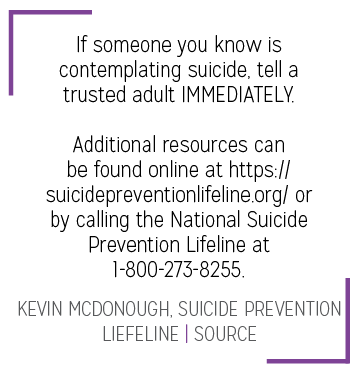In sixth grade, I remember reading Jay Asher’s original 288-page novel and explaining to my friends the basic premise of the story. I remember being asked, “Why would you ever read a book as disturbing as that?” So, for me, it is surprising that five years later, it seems as if all of my friends have watched the TV version of the book. Now, as somebody who read the book and (binge) watched the TV series “Thirteen Reasons Why,” I found the visual depiction of the television series to completely miss the mark.
When I read the book and watched the show, I found myself sympathizing for Hannah Baker’s sense of powerlessness. Initially, I admired her endurance through toxic friendships. As the show continued, it emphasized Hannah’s feelings of lack of control, specifically through graphic depictions of sexual assault. For Hannah, recording those tapes was an attempt to control her classmates’ reactions. There are two deep flaws with this logic. First, this is a dangerously manipulative message to send. Second, no matter how powerless Hannah felt, suicide should never be a mechanism to obtain power. The TV show grossly romanticizes and dramatizes the struggle Hannah endured and uses it to seemingly justify suicide. While the trials and tribulations Hannah endures are truly heartbreaking to watch and even harder to empathize with, ultimately the TV show portrays her as heroic for making it through every day and paints suicide as the inevitable outcome.
The television series also portrays Hannah’s suicide in a very different way. In the book, it is implied that she swallowed a handful of pills. In the television series, Hannah slits her wrists with razor blades, which is extremely graphic and horrible to watch. While I understand how this decision exposes the grotesque reality of suicide, after reading the book it felt like this method was chosen to simply dramatize the show.
 Most importantly, the story’s main lesson is to remind students that words have unprecedented effects, so we should treat everybody with kindness. However, it shouldn’t take the tragic suicide of a classmate for students everywhere to realize what should be the obvious. Even after the death of Hannah Baker, her classmates continued to treat their friends and classmates horribly, showing little growth. Overall, I wish there was more specificity about the mental health perspective on suicide. Clearly, through Hannah’s actions and thought processes she was experiencing some form of depression. There is a complicated mix of emotional issues within each character, and the TV show and book missed the mark in emphasizing the mental illness issue within high school teens. Perhaps more secure suicide prevention and kinder relationships would result from this perspective.
Most importantly, the story’s main lesson is to remind students that words have unprecedented effects, so we should treat everybody with kindness. However, it shouldn’t take the tragic suicide of a classmate for students everywhere to realize what should be the obvious. Even after the death of Hannah Baker, her classmates continued to treat their friends and classmates horribly, showing little growth. Overall, I wish there was more specificity about the mental health perspective on suicide. Clearly, through Hannah’s actions and thought processes she was experiencing some form of depression. There is a complicated mix of emotional issues within each character, and the TV show and book missed the mark in emphasizing the mental illness issue within high school teens. Perhaps more secure suicide prevention and kinder relationships would result from this perspective.
The views in this column do not necessarily reflect the views of the HiLite staff. Reach Hannah Glazier at hglazier@hilite.org.































![What happened to theater etiquette? [opinion]](https://hilite.org/wp-content/uploads/2025/04/Entertainment-Perspective-Cover-1200x471.jpg)














































![Review: “The Immortal Soul Salvage Yard:” A criminally underrated poetry collection [MUSE]](https://hilite.org/wp-content/uploads/2025/03/71cju6TvqmL._AC_UF10001000_QL80_.jpg)
![Review: "Dog Man" is Unapologetically Chaotic [MUSE]](https://hilite.org/wp-content/uploads/2025/03/dogman-1200x700.jpg)
![Review: "Ne Zha 2": The WeChat family reunion I didn’t know I needed [MUSE]](https://hilite.org/wp-content/uploads/2025/03/unnamed-4.png)
![Review in Print: Maripaz Villar brings a delightfully unique style to the world of WEBTOON [MUSE]](https://hilite.org/wp-content/uploads/2023/12/maripazcover-1200x960.jpg)
![Review: “The Sword of Kaigen” is a masterpiece [MUSE]](https://hilite.org/wp-content/uploads/2023/11/Screenshot-2023-11-26-201051.png)
![Review: Gateron Oil Kings, great linear switches, okay price [MUSE]](https://hilite.org/wp-content/uploads/2023/11/Screenshot-2023-11-26-200553.png)
![Review: “A Haunting in Venice” is a significant improvement from other Agatha Christie adaptations [MUSE]](https://hilite.org/wp-content/uploads/2023/11/e7ee2938a6d422669771bce6d8088521.jpg)
![Review: A Thanksgiving story from elementary school, still just as interesting [MUSE]](https://hilite.org/wp-content/uploads/2023/11/Screenshot-2023-11-26-195514-987x1200.png)
![Review: "When I Fly Towards You", cute, uplifting youth drama [MUSE]](https://hilite.org/wp-content/uploads/2023/09/When-I-Fly-Towards-You-Chinese-drama.png)
![Postcards from Muse: Hawaii Travel Diary [MUSE]](https://hilite.org/wp-content/uploads/2023/09/My-project-1-1200x1200.jpg)
![Review: "Ladybug & Cat Noir: The Movie," departure from original show [MUSE]](https://hilite.org/wp-content/uploads/2023/09/Ladybug__Cat_Noir_-_The_Movie_poster.jpg)
![Review in Print: "Hidden Love" is the cute, uplifting drama everyone needs [MUSE]](https://hilite.org/wp-content/uploads/2023/09/hiddenlovecover-e1693597208225-1030x1200.png)
![Review in Print: "Heartstopper" is the heartwarming queer romance we all need [MUSE]](https://hilite.org/wp-content/uploads/2023/08/museheartstoppercover-1200x654.png)



